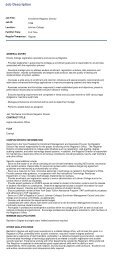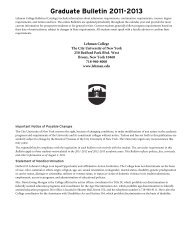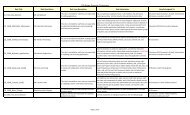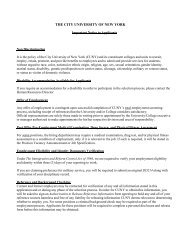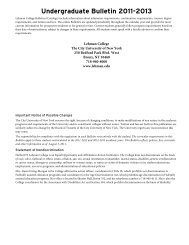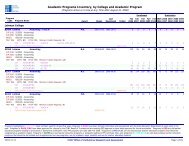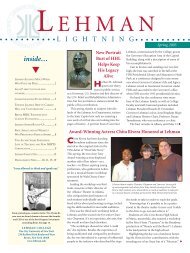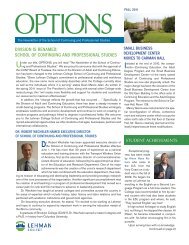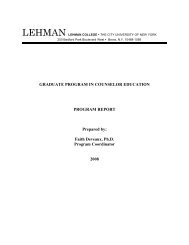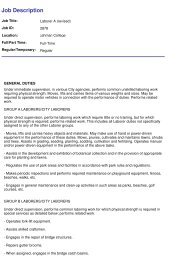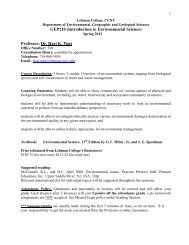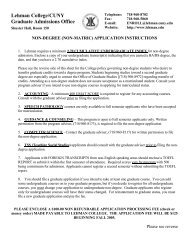AACTE Relationships Roundtable-4.docx - Lehman College
AACTE Relationships Roundtable-4.docx - Lehman College
AACTE Relationships Roundtable-4.docx - Lehman College
Create successful ePaper yourself
Turn your PDF publications into a flip-book with our unique Google optimized e-Paper software.
MATH-UP: Teacher Quality Project<br />
<strong>Lehman</strong> <strong>College</strong><br />
City University of New York<br />
Harriet R. Fayne, Principal Investigator<br />
Arlene Demy Weinstein, Project Director<br />
The Impact of <strong>Relationships</strong> on School/<strong>College</strong><br />
Partnership Success<br />
<strong>AACTE</strong> <strong>Roundtable</strong><br />
Orlando, Florida<br />
March 1, 2013<br />
MATH-UP Faculty Investigators<br />
Laura Roberts<br />
Anne Marie Marshall<br />
Harriet Fayne<br />
Cecilia Espinosa<br />
Maria Victoria Rodriguez
Introduction<br />
The overarching goal of Mathematics Achievement with Teachers of High-need Urban<br />
Populations (MATH-UP), a federally and state funded Teacher Quality Project, is to effect<br />
simultaneous reform of an urban teacher preparation graduate program and low-performing urban<br />
schools. To achieve that end, an elementary teacher education program at <strong>Lehman</strong> <strong>College</strong> (City<br />
University of New York), a public, Hispanic-Serving Institution, forged a partnership with five<br />
South Bronx elementary schools, Educational Testing Service, Research for Better Schools, and a<br />
local cable network. MATH-UP involves both a course of study leading to a masters degree<br />
offered by the School of Education and a clinical residency in which candidates work in tandem<br />
with cooperating teachers who are active participants in school-based professional learning<br />
communities and engage in ongoing professional development in the areas of mathematics<br />
content and pedagogy, formative assessment, and mentoring.<br />
Our roundtable will offer some tentative, contextualized answers to questions about whether<br />
preparing teachers for high needs urban elementary schools requires unique kinds of preparation<br />
and support structures across the teacher development continuum. Embedded throughout MATH-<br />
UP activities is the theme of collaboration: co-developed orientation and in-service sessions for<br />
program participants, “critical friend” review of program evaluation data to enhance effectiveness,<br />
and co-teaching in college and K-6 classrooms.<br />
Mentoring<br />
Laura Roberts, Investigator<br />
Since the late seventies mentoring has been researched extensively in a variety of professional<br />
venues (Ehrich, Hansford, & Tennent, 2004). Subsequently, researchers have linked mentoring<br />
to a variety of positive outcomes. Among the various benefits associated with mentoring are<br />
increases in career satisfaction and skills related to the profession and improvements in areas of<br />
psychosocial functioning (Allen, Eby, Poteet, Lentz, E., & Lima, 2004; Ostroff & Kozlowski,<br />
1993). In studies of novice teachers, researchers have found that mentoring was an effective tool<br />
for alleviating feelings of isolation and lack of support, two problems commonly reported by first<br />
year teachers (Andrews & Quinn, 2005). Furthermore, mentoring has been associated with<br />
professional learning and overall retention of both veteran and first year teachers (Gardiner,<br />
2012; Watkins & Scott 2007).<br />
Traditionally, mentoring entails the process of pairing together an individual with limited<br />
experience (mentee) with another who is believed to possess a particular area of expertise and
skill set (mentor). According to Ambrosetti and Dekkers (2010) “mentoring is a non-hierarchical,<br />
reciprocal relationship between mentors and mentees who work towards specific professional<br />
and personal outcomes for the mentee.” Through guidance, advisement and modeling, the<br />
mentor assists the mentee in developing his/her set of professional skills and expertise (Chao,<br />
1997; Kram, 1985). Mentoring, recognized as essential to the learning and preparation of<br />
individuals new to the teaching profession, has become common practice in many teacher<br />
induction and education programs across the country (Darling-Hammond, 2006; Carver &<br />
Feiman- Nemser, 2009).<br />
A number of factors have been found to be linked to the positive outcomes associated with<br />
mentoring programs; among those factors is the mentor/mentee relationship. As with most<br />
relationships, that between pre-service teaching candidates and mentor teachers is often complex<br />
(Leshem, 2012). Differences in perception about roles, responsibilities and expectations of the<br />
mentoring process can leave both the mentor and mentee feeling dissatisfied with the mentoring<br />
experience. In examining mentoring relationships, researchers have found that when the mentors<br />
and mentees possess similar values, goals and perceptions they are more likely to experience<br />
satisfaction in the mentoring process. Furthermore, emotional supports provided by mentors have<br />
been found to contribute to feelings of competence and effectiveness in mentees (Greiman,<br />
Torres, Burris & Kitchel, 2007). Emotional supports in the mentoring relationships are referred<br />
to as psychosocial functions. Kitchel (2006) identified specific psychosocial functions as being<br />
essential to building a successful mentoring relationship. Among these functions are: modeling,<br />
counseling, and connecting on a personal/social level (Kitchel, Greiman, Torres & Burris, 2008;<br />
Kitchel, 2006).<br />
Perhaps one of the most critical components of the MATH-UP program is the mentoring aspect.<br />
The formal pairing process took place over the 12 months prior to the first year of<br />
implementation, during which time program staff and faculty gathered data on program<br />
participants and the different school sites. Members of the MATH-UP team visited each of the<br />
five participating schools on a regular basis, conducting classroom observations and meeting<br />
with potential mentor teachers and building staff. The purpose of these visitations was to gain a<br />
better understanding of the climate in each of the schools, to establish rapport with the teachers,<br />
and to learn about different aspects of prospective mentors’ personalities. During the spring<br />
semester prior to implementation, pre-service teaching candidates (mentees) were observed in a<br />
graduate level class taught by the MATH-UP program’s clinical coordinator. By mid-semester,<br />
the mentees traveled as a group to each of the participating schools and had the opportunity to<br />
give feedback on their preferences for placement. Prior to the end of the spring semester (Year<br />
Two), MATH-UP staff reviewed all of the data and paired the 18 interns with mentors (Cohort<br />
One).<br />
Research Questions:
This study aimed to answer the following questions pertaining to the mentoring relationship:<br />
●<br />
●<br />
●<br />
To what degree did mentees feel that their mentors provided them with psychosocial<br />
supports (e.g. acceptance, friendship and role-modeling)? To what degree did mentors<br />
perceive that they provided such supports?<br />
To what extent did mentees need assistance in areas related to teacher responsibilities?<br />
Were mentors able to provide it?<br />
What did mentors and mentees perceive to be the benefits of participating in the<br />
mentoring relationship? Did they identify barriers to success?<br />
Instrumentation:<br />
Mentoring Relationship Questionnaire: Data were gathered using a modified version of the<br />
Mentoring Relationship Questionnaire (MRQ, Greiman, 2003). This particular questionnaire<br />
examines the perspectives of mentors and mentees on the following aspects of the mentoring<br />
relationship: psychosocial functions, perceived levels of support required and the extent to<br />
which support was provided. The MRQ also examines mentor/mentee perceptions of similarities<br />
to one another, overall satisfaction with the relationship and barriers to success.<br />
Findings:<br />
The initial analysis of the data gathered through the MRQ revealed that mentors and mentees<br />
shared similar perceptions of the types of support required for mentees to be successful. Specific<br />
areas, in which mentees needed the most assistance, were: assisting students with special needs,<br />
navigating school politics, conducting parent conferences, evaluating student work,<br />
implementing school policies, managing time and daily tasks, managing classroom and student<br />
behavior, motivating students, lesson planning, self-reflection and differentiated instruction.<br />
Responses related to mentor teachers’ ability to provide support in these areas indicated that<br />
disparities existed between perceptions of mentors and mentees.<br />
Mentor/mentee responses to items pertaining to the psychosocial functions of the mentoring<br />
relationship showed similarities. Responses show that mentees believed that mentors thought<br />
highly of them as both interns and colleagues, served as role models, conveyed feelings of<br />
respect, and provided them with support and encouragement. Disparities existed between<br />
mentors and mentees in terms of the extent to which mentors shared personal experiences, were<br />
individuals that the mentee could trust and made themselves available as confidantes.<br />
Responses indicate that mentors believed they had provided these supports; interns were not<br />
entirely convinced that they had done so.
The findings in this study are consistent with other research that has identified the difficulties<br />
experienced by teachers new to the teaching profession (Bickmore & Bickmore, 2010; Fantilli,<br />
& McDougall, 2009). While all of the mentees had received training related to the teaching<br />
profession prior to and during the internship, they still had learning gaps associated with<br />
transitioning from teacher preparation programs into the teaching profession. Mentees rated<br />
mentors as adequately prepared to provide support. However, mentors perceived themselves as<br />
more capable than did the mentees. Concerns around mentor competence have emerged in other<br />
studies, particularly when mentees indicated that they were dissatisfied with the mentoring<br />
relationship (Fantilli, & McDougall, 2009). However, in general, mentees’ responses overall on<br />
the MRQ indicated high levels of satisfaction with the mentoring process.<br />
It appeared that mentors were not as skillful at mentoring as they perceived themselves to be. An<br />
individual’s belief about his or her ability to complete a particular task, known as self-efficacy, is<br />
typically based on what he or she understands is required in order to successfully complete the<br />
task (Bandura, 1997). Higher teacher self-efficacy is linked to positive student outcomes in<br />
terms of behaviors, attitude and achievements; it tends to foster virtues such as perseverance and<br />
resiliency, which are two necessities for dealing with challenging situations (Tschannen-Moran,<br />
Woolfolk Hoy & Hoy, 1998). So, our mentors, selected because of their reputation as teachers,<br />
may have incorrectly assumed that they were as successful with fledgling teachers as they were<br />
with their students.<br />
Works Cited<br />
Allen, T. D., by, . T., Poteet, . ., ent , ., ima, . (200 ). areer benefits associated<br />
with mentoring for prot g s A meta-analysis. Journal of Applied Psychology, 89, 127-136.<br />
Ambrosetti, A. & Dekkers, J. (2010). The interconnectedness of the roles of mentors and<br />
mentees in pre-service teacher education mentoring relationships. Australian Journal of Teacher<br />
Education, 35(6), 42-55.<br />
Andrews, B., & Quinn, R. J. (2005). The effects of mentoring on first-year teachers' perceptions<br />
of support received. Clearing House, 78(3), 110-116.<br />
Bandura, A. ~1995!. Self-efficacy in changing societies. New York: Cambridge University Press.<br />
Bickmore, D.L., & Bickmore, S.T. (2010). A multifaceted approach to teacher induction.<br />
Teaching and Teacher Education, 26 1006-1014<br />
Carver, C. L., & Feiman-Nemser, S. (2009). Using policy to improve teacher education: Critical<br />
elements and missing pieces. Educational Policy, 23(2), 295-328.
Darling-Hammond, L. (2006). Powerful teacher education: Lessons from exemplary programs.<br />
San Francisco, CA; Jossey-Bass.<br />
Ehrich, L. C., Hansford, B., & Tennent, L. (2004). Formal mentoring programs in education and<br />
other professions: A review of the literature. Educational Administration Quarterly, 40(4), 518-<br />
540.<br />
Fantilli, R. D., & McDougall, D. E. (2009). A study of novice teachers: Challenges and supports<br />
in the first years. Teaching & Teacher Education, 25(6), 814-825.<br />
Gardiner, W. (2012). Coaches' and new urban teachers' perceptions of induction coaching: Time,<br />
trust, and accelerated learning curves. The Teacher Educator, 47(3), 195-215.<br />
Greiman, B.C. (2003). Providing professional and psychosocial assistance for beginning<br />
agriculture teachers: The perceptions of formal mentors and novice teachers. Unpublished<br />
doctoral dissertation, University of Missouri-Columbia.<br />
Greiman, B. ., Torres, R. ., Burris, S., Kitchel, T. (2007). Beginning teachers’ perceptions<br />
of in -school and in-profession mentoring relationships. Career and Technical Education<br />
Research, 32(1), 23-44<br />
Kram, K. E. (1985). Mentoring at work: Developmental relationships in organizational life.<br />
Glenview, IL: Scott, Foresman.<br />
Kitchel, T., Greiman, B. C., Torres, R. M., & Burris, S. (2008). The influence of gender on<br />
relationship aspects of beginning teachers and their mentors. Career & Technical Education<br />
Research, 33(2), 73-91.<br />
Kitchel, T. (2006). Perceived differences, by gender, in student teacher-cooperating teacher<br />
interactions. Journal of Southern Agricultural Education Research, 56(1),62-75.<br />
Leshem, S. (2012). The many faces of mentor-mentee relationships in a pre-service teacher<br />
education programme. Creative Education, 3(4), 413-421.<br />
Ostroff, C., & Kozlowski, S. W. (1993). The role of mentoring in the information gathering<br />
processes of newcomers during early organizational socialization. Journal of Vocational<br />
Behavior, 42, 170-183.
Russell, M. I., & Russell, J. A. (2011). Mentoring relationships: Cooperating teachers’<br />
perspectives on mentoring student interns. The Professional Educator, 35.<br />
Tauer, S. M. (1998). The mentor-protégé relationship and its impact on the experienced teacher.<br />
Teaching & Teacher Education, 14 (2), 205-218<br />
Tschannen-Moran, M., Woolfolk Hoy, A., & Hoy, W. K. (1998). Teacher efficacy: Its meaning<br />
and measure. Review of Educational Research 68, 202-248.<br />
Watkins, L., & Scott, D. G. (2008). Retention of early career teachers engaged in Missouri 50<br />
career education mentoring program: A longitudinal study. Retrieved from<br />
http://missouricareer-education.org/pd/mentoring/tNotebook/2008-mentor-study.pdf<br />
Co-Teaching<br />
Anne Marie Marshall & Harriet Fayne, Co-Investigators<br />
For over thirty years, co-teaching has been employed to support inclusive practices in P-12<br />
classrooms (Pugach & Winn, 2011; Scruggs, Mastropieri, & McDuffie, 2007). There are both<br />
quantitative as well as qualitative data linking positive student outcomes (Gerber & Popp, 2000;<br />
Rea, McLaughlin, & Walter-Thomas, 2002) and enhanced professional growth in teachers<br />
(Scruggs et al., 2007) to co-teaching. While less attention has been paid to co-teaching in higher<br />
education than in P-12, there is a body of case literature that describes successful pedagogical<br />
partnerships forged between regular and special teacher educators, faculty within and across<br />
disciplines (Lester & Evans, 2009), college/university faculty and practicing teachers (Buczynski<br />
& Sisserson, 2008), student teachers and mentors (Bacharach, Heck& Dahlberg, 2010), and<br />
teams of pre-service candidates (Gardiner & Robinson, 2009).<br />
Co-teaching is first and foremost a relationship that develops between or among individuals who<br />
share responsibility for an instructional “space.” ussanti and Pence (2010), in their qualitative<br />
study of a collaborative professional development model designed to enhance teachers’ ability to<br />
work with nglish anguage earners, concluded “ ven though the project was aimed at<br />
increasing teachers’ S pedagogical content knowledge, o-Facilitators talked more about their<br />
emotional engagement and intersubjectivity with their partners and Guest Teachers. Relationship<br />
trumped knowledge, and in doing so, highlights the need for studying the interactional<br />
dimensions of teacher change” (p. 87). Successful co-teaching relationships are built upon shared<br />
knowledge and interdependence. Autonomy and individualism, cherished by teachers who are<br />
used to working independently, are de-emphasized in a collaborative culture.
If teacher education programs incorporate co-teaching models in courses and clinical practice<br />
settings, is it possible to whittle away at the notion that teaching is a solitary activity, a<br />
preconception that can lead to a sense of alienation and isolation in novice urban teachers? Will<br />
partnerships at the micro-level (classroom) lead to enhanced understanding and a narrowing of<br />
the theory-practice gap at the meso- (program) and macro- (institutional) levels?<br />
In the MATH-UP program, co-teaching relationships exist between teacher interns and their<br />
mentor teachers. In addition, co-teaching relationships exist at the college level between the two<br />
instructors of MATH-UP courses. The college level co-teaching model allows instructors to<br />
teach in ways that are not possible with just one instructor. Consequently, interns are afforded<br />
richer experiences and are provided with more help due to the strengths of having two qualified<br />
instructors. Experiencing multiple co-teaching strategies as learners helps interns to understand<br />
the various co-teaching practices.<br />
Teacher candidates in the MATH-UP program take 14 core courses, 12 of which are co-taught.<br />
These courses pair a <strong>Lehman</strong> <strong>College</strong> Faculty member with P-6 teachers, coaches, or<br />
administrators from the host schools participating in the program. Of these 12 co-taught courses,<br />
seven are co-taught by one university instructor and one classroom teacher, three are co-taught<br />
by one adjunct instructor and one classroom teacher, one is co-taught by the School of Education<br />
Dean and the MATH-UP project director, and one is co-taught be two classroom teachers. It was<br />
the goal of the co-teaching component that MATH-UP interns would learn to co-teach through<br />
explicit instruction about co-teaching models as well as through various opportunities to<br />
experience co-teaching as learners. In essence, co-taught courses were designed to model what<br />
we wanted interns to practice. By doing this, we were aiming to narrow the theory to practice<br />
gap. Research by Darling-Hammond and Bransford (2005) urges teacher programs to find<br />
stronger connections between theory and practice, calling for opportunities to find connections<br />
between coursework and fieldwork in efforts to support teacher candidates.<br />
Our research aims to understand how co-taught courses affected preservice interns<br />
understandings and application of co-teaching models.<br />
●<br />
●<br />
●<br />
What elements of co-teaching are necessary for successful pedagogical partnerships?<br />
What can we learn from the experiences of co-teaching partnerships between university<br />
faculty and practicing teachers that will help us understand co-teaching opportunities for<br />
our interns?<br />
Using ‘relationship trumps knowledge’ ( ussanti and Pence, 2010), as a starting<br />
assumption, what aspects of relationships are most important in co-teaching<br />
relationships?
Initial Findings: While informal communication indicated that everything was going smoothly in<br />
the co-taught courses, analysis of the data has revealed that some co-teaching relationships were<br />
functioning at a higher level than others. Initial data analysis is revealing aspects of co-teaching<br />
that may illuminate elements of co-teaching necessary for successful pedagogical partnerships.<br />
Several themes have emerged from the university/instructor data on co-teaching. For example,<br />
both groups voiced concerns about preparedness to co-teach and lack of sufficient time to coplan.<br />
In this paper, we will focus on the relational aspects of co-teaching in <strong>Lehman</strong> courses.<br />
Here, we present three preliminary themes that have emerged. Below is an excerpt from the<br />
theme analysis from three co-teaching relationships (two of which use one university instructor<br />
as the common instructor).<br />
Trust<br />
+”Few conflicts, rely on one another, rewarding, I feel comfortable with joint-decision making,<br />
learning from each other, sharing responsibilities- I trust that the other is doing the work”<br />
-“Gave him the easiest to grade, feels guarded, communicate infrequently and superficially,<br />
afraid to assign meaningful or important tasks, feels the need to ‘assign’ rather than co-plan”<br />
Partnership and Mutual Respect<br />
+ “Using “we” is easy, established norms for working together, acknowledging strengths in<br />
partner, feelings of inclusion, clicked, have each other back (picked up slack when one partner<br />
needed it and this was reciprocated”<br />
-“Using ‘we’ is not natural, ommunication is broken (not showing up- me not being clear about<br />
expectations, roles, speaking up), one partner having to constantly ‘pick up the slack’”<br />
Presence<br />
+ “Regular communication in person, online, over the phone, ongoing individual and paired<br />
reflection of roles, being proactive in trying multiple strategies, understanding and reflection on<br />
how co-teaching roles impact student learning”<br />
- “Doesn’t show up- for some of these I was notified via text the day of or the day before. This<br />
lack of physical presence exacerbates his lack of presence as a co-teacher, and lack of time with<br />
students- creates an unbalanced relationship with students, even when he was ‘there’, he just sat<br />
there”<br />
Typically, college professors are prepared for teaching their classes alone and have worked to<br />
improve them over time. Co-teaching can be a vulnerable activity. Co-teaching can expose<br />
strengths as well as weaknesses. There may be a power differential, with one member of the<br />
team having more authority than another. In addition, accountability is likely to play a role in<br />
how the co-teaching relationship evolves (i.e., The teacher of record is ultimately responsible for<br />
student success and may be evaluated negatively if the course does not go well). One of the<br />
research goals of MATH-UP is to develop a nuanced understanding of how co-teaching is
enacted within and across settings. Our initial findings, based on self-study of teaching practices,<br />
survey data, and semi-structured interviews, indicate that co-teaching at the collegiate level<br />
stretches teacher educators and brings them closer to the lived experience of candidates and<br />
cooperating teachers.<br />
Works Cited<br />
Bacharach, N., Heck, T.W. & Dahlberg, K. (2010). Changing the face of student teaching<br />
through coteaching. Action in Teacher Education, 32 (1), 3-14.<br />
Bacharach, N., Heck, T.W. & Dahlberg, K. (2008). Co-teaching in higher education. Journal of<br />
<strong>College</strong> Teaching and Learning, 5(3), 9-16.<br />
Buczynski, S. & Sisserson, K. (2008). School district and university co-teaching: Toward<br />
instructional synergy in an induction/M.Ed. program. Issues in Teacher Education, 17(1), 47-73.<br />
Darling-Hammond, L. and Bransford, J., Eds. (2005). Preparing Teachers for a Changing<br />
World: What Teachers Should Learn and Be Able to Do. San Francisco, CA: Jossey-Bass.<br />
Gardiner, W. & Robinson, K.S. (2009). Paired field placements: A means for collaboration. The<br />
New Educator, 5, 81-94.<br />
Gerber, P. J., & Popp, P. A. (2000). Making collaborative teaching more effective for<br />
academically able students: Recommendations for implementation and training. Learning<br />
Disability Quarterly, 23(3), 229-236.<br />
ester J.N. vans, K.R. (2009). Instructors’ experiences of collaboratively teaching: Building<br />
something bigger. International Journal of Teaching and Learning in Higher Education, 20 (3),<br />
373-382.<br />
Musanti, S.I. & Pence, L. (2010). Collaboration and teacher development: Unpacking resistance.<br />
Teacher Education Quarterly, 37 (1), 73-89.<br />
Pugach, M.C. & Winn, J.A. (2011). Research on co-teaching and teaming: An untapped resource<br />
for induction. Journal of Special Education Leadership, 24 (1), 36-46.
Rea, P. J., McLaughlin, V. L., & Walter-Thomas, C. (2002). Outcomes for students with learning<br />
disabilities in inclusive and pullout programs. Exceptional Children, 68(1), 203-222.<br />
Scruggs, T., Mastropieri, M., & McDuffie, K. (2007). Co- teaching in inclusive classrooms: A<br />
metasynthesis of qualitative research. Exceptional Children, 73 (4), 392-416.<br />
Vermette, P.J., Jones, K.A., & Jones, J.L. (2010). Co-teaching in the university setting: Promise<br />
and practice in teacher education. National Teacher Education Journal, 3 (3), 50-57.<br />
Teacher Learning Communities<br />
Cecilia Espinosa and Maria Victoria Rodriguez, Co-Investigators<br />
For school reform to have a long lasting effect on teacher practice, it must include professional<br />
development that reduces teacher isolation, emphasizes teacher expertise, and promotes<br />
collaboration (Saxe, Gearheart, and Nasir, 2001; Wei, 2009). What matters is that trusting<br />
relationships (Elster, 2009) are built over time and that teachers have opportunities to engage in<br />
high quality, student-focused conversations (Reich and Bally, 2011). Changing practice is a<br />
complex process. It requires learning and unlearning (Shen, 2002). Wood (2007) argues that,<br />
“ earning communities offer opportunities not only to tap teachers’ knowledge, but to make it<br />
public, so it can be both shared and the teacher can engage with others in critical dialogue” (p.<br />
282). In these learning communities teachers develop an identity as professionals who raise<br />
issues about their practice, inquire into possible solutions, and build knowledge together from<br />
their daily work, as well as from the professional literature (Wood, 2007; Whitford & Wood,<br />
2010).<br />
Teacher Learning Communities (TLC) offer participants opportunities to deepen their<br />
pedagogical understandings by engaging in collective inquiry in order to examine their daily<br />
practice, improve student learning, and construct new knowledge about teaching and learning. In<br />
these communities participants develop identities as professionals who raise issues about their<br />
practice, inquire into possible solutions, and build knowledge from their daily work.<br />
The Teacher Learning Communities meetings in the MATH UP program are one of the<br />
professional development opportunities that cooperating teachers and prospective teachers had<br />
together during the 2011-2012 school year. During these monthly TLC meetings participants<br />
engaged in learning about the Keeping Learning on Track (KLT) strategies<br />
(http://www.nwea.org/KLT), reflecting on their application in the classroom, and planning for<br />
the continuous and effective implementation of strategies.
This presentation focuses on the preliminary data analysis of data collected during the year 2011-<br />
2012 (second year of a two-year study). For the purpose of this presentation we began to analyze<br />
audiotapes of monthly TLC sessions at two of the partner schools. A research assistant listened<br />
to all of the audiotapes and prepared summaries. We are in the process of having audiotapes<br />
transcribed; consequently, we want to emphasize that these are emerging results.<br />
Our investigation centers on what happens when teachers, teacher candidates and college faculty<br />
in two urban schools with children with special needs and a large population of second language<br />
learners come together through a clinically rich TQP project to establish a dialogue about<br />
improving student learning through the use of formative assessments (KLT Strategies). The<br />
purpose of this study is to continue investigating what happens during the second year of<br />
participation in the TLC communities.<br />
This presentation focuses on the following questions:<br />
● What are the salient themes that emerge as we analyze 2011-2012 TLC data?<br />
● What is missing in the conversations? What are areas of concern?<br />
● How can the data inform decisions about how to improve TLC sessions?<br />
Initial Findings: We found evidence that the TLC sessions provided a space for teachers to raise<br />
issues about their practice and hear one another’s struggles as they attempted to learn new ways<br />
of addressing the needs of the children they teach. In addition, these meetings provided an<br />
opportunity for interns to think about their professional identity while they participated in critical<br />
conversations about practice with seasoned teachers. The conversations were richer when<br />
teachers brought student work from their own classrooms and thought about specific strategies to<br />
meet the needs of particular children.<br />
While KLT printed materials contain a large number of activities, they are not necessarily<br />
focused on the elementary school curriculum, specifically the early elementary school<br />
curriculum. For example, when learning about rubrics, the participants were asked to design<br />
jeans using rubrics at various levels of development. We noticed that the TLC groups had<br />
difficulty transferring the learning intentions of this activity to their daily work with elementary<br />
children. The activity with the jeans became an activity by itself rather than a vehicle for<br />
thinking about the use of appropriate rubrics and their impact on student learning.<br />
In addition, the last two activities on the agenda (Action Planning and Summary of Learning) are<br />
scheduled to take place during the last 20 minutes of each meeting. Often by this time the<br />
meeting was over. Participants were eager to leave. Consequently, little or no time was dedicated<br />
to these two important activities. The KLT manual recommends that the three most important
activities to complete are activities two [How is it going?], four [Action Planning], and five<br />
[Summary of Learning].<br />
We think that the Summary of Learning and Action Planning activities are excellent ways of<br />
helping teachers to make connections between KLT activities and their practice. Therefore, if the<br />
group does not give full attention to these two important components of the agenda, the potential<br />
impact on practice is not realized. Although participants may be thinking about how to employ<br />
KLT strategies on their own, we are arguing that more time should be allocated during TLC<br />
meetings to making explicit connections between the techniques discussed and how they are<br />
enacted in the classroom.<br />
An open and thoughtful discussion about the implications and challenges as well as successes<br />
and new wonderings can only benefit everyone in the group. The place in the agenda where the<br />
participants could not only discuss but also bring evidence of how their Action Plan was<br />
implemented is in the section, “How is it Going?” If participants had brought stronger evidence<br />
of their action plans to TLC meetings, they could have taken more of an inquiry stance and<br />
engaged in action research. The TLC meetings have the potential to be a safe place where<br />
teachers and prospective teachers discuss how to address the challenges in making the KLT<br />
strategies an integral part of their daily practice. With limited sharing of action plans, the group<br />
missed the opportunity to engage in deep discussions.<br />
Finally, there is no doubt that the TLC sessions and having the prospective teachers as interns in<br />
their classrooms on a daily basis are valued by the participants. Several of the teachers are<br />
thinking about how to maintain both aspects once the MATH-UP project is officially over. At a<br />
TLC session a teacher asked:<br />
“Teacher 1: [Interrupting previous speaker]: Before we move on, I have one quick one. I see<br />
that there is a lot of success with this program, with having the preservice teachers. I just<br />
wonder what is going to happen after?”<br />
Works Cited<br />
lster, D. (2009). Biology in ontext Teachers’ professional development in learning<br />
communities. Journal of Biological Education, 43 (2), 53-61.<br />
Reich, G.A. & Bally, D. (2010). Get smart: Facing high-stakes Testing together. Social Studies.<br />
June, 2010.
Saxe, G., Gearhart, ., Nasir, N. S. (2001). nhancing students’ understanding of<br />
Mathematics: A study of three contrasting approaches to professional support. Journal of<br />
Mathematics Teacher Education, 4, 55-79.<br />
Shen (2002). Student teaching in the context of school-university partnership: A case study of a<br />
student teacher. Education, 122 (3): 564-580.<br />
Wei, R. C., Darling-Hammond, L., Andree, A., Richardson, N., Orphanos, S. (2009).<br />
Professional learning in the learning profession: A status report on teacher development in the<br />
United States and abroad. Dallas, TX: National Staff Development Council.<br />
Withford, B. L. & Wood D. R. (2010). Teachers Learning in Community: Realities and<br />
Possibilities. NY: Sunny Press.<br />
Wood, D. R. (2007). Professional learning communities: Teachers, knowledge, and knowing.<br />
Theory Into Practice, 46(4), 281–290.<br />
Conclusion<br />
While there is growing consensus around the claim that collaboration is an essential ingredient in<br />
both school and teacher education reform, there are obstacles that reduce the likelihood that a<br />
collaborative culture will develop or sustain itself within schools or the academy, let alone<br />
between schools and higher education institutions. The MATH-UP project, with its emphasis on<br />
partnerships and community building, challenges the assumption that, in the present climate,<br />
teachers (and teacher educators) can or should operate autonomously and independently if we<br />
expect to achieve the ambitious goal of getting all children to realize their potential.<br />
Time comes up either implicitly or explicitly as a variable that can facilitate or impede progress.<br />
How can we find the time to form the relationships that lead to honest, productive<br />
communication among mentors and mentees, college faculty and practitioners, and teachers<br />
within a school? Dr. Roberts shared the following astute observation in a recent email:<br />
“ Interesting that time is a common thread. I wonder if there is a connection between time and<br />
perceived benefits of collaboration (personal and/or collective). In other words, most of us,<br />
miraculously, find time to participate in things if we feel that the pros of doing so outweigh the<br />
cons.” We will interrogate the notion of perceived cost/benefit ratios of various aspects of the<br />
MATH UP model as the project enters its final stage.



